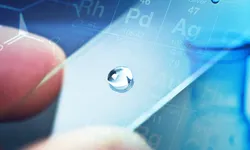
Phase Diagrams I & II 
This course will explore phase diagrams and their use in determining the state of a material based on temperature and composition. Students will learn how to manipulate microstructure and materials properties through temperature and composition, with a focus on the eutectic phase diagram. ▼
ADVERTISEMENT
Course Feature
![]() Cost:
Cost:
Free
![]() Provider:
Provider:
Coursera
![]() Certificate:
Certificate:
Paid Certification
![]() Language:
Language:
English
![]() Start Date:
Start Date:
22nd May, 2023
Course Overview
❗The content presented here is sourced directly from Coursera platform. For comprehensive course details, including enrollment information, simply click on the 'Go to class' link on our website.
Updated in [March 06th, 2023]
This course provides an overview of phase diagrams and their use in materials science. Students will learn how to interpret phase diagrams and how to use them to determine the state of a material as a function of temperature and composition. The course will also explore how the microstructure and materials properties can be manipulated as a function of temperature and composition. A special focus will be on the eutectic phase diagram. By the end of the course, students will have a better understanding of phase diagrams and their applications in materials science.
[Applications]
The application of this course can be seen in the design of materials and components. By understanding the phase diagrams, engineers can determine the best material and composition for a given application. This knowledge can be used to optimize the performance of a material or component, as well as to reduce costs. Additionally, the knowledge of phase diagrams can be used to predict the behavior of a material or component under different conditions.
[Career Paths]
1. Materials Scientist: Materials Scientists study the structure and properties of materials, such as metals, ceramics, polymers, and composites, and develop new materials with specific properties. They use phase diagrams to understand the behavior of materials and develop new materials with desired properties. With the increasing demand for new materials in the automotive, aerospace, and medical industries, the demand for Materials Scientists is expected to grow.
2. Metallurgist: Metallurgists use phase diagrams to understand the behavior of metals and alloys. They use this knowledge to develop new alloys with desired properties, such as strength, corrosion resistance, and thermal conductivity. With the increasing demand for new alloys in the automotive, aerospace, and medical industries, the demand for Metallurgists is expected to grow.
3. Chemical Engineer: Chemical Engineers use phase diagrams to understand the behavior of chemical systems and develop new processes for producing chemicals. They use this knowledge to develop new processes for producing chemicals with desired properties, such as purity, yield, and cost. With the increasing demand for new chemicals in the automotive, aerospace, and medical industries, the demand for Chemical Engineers is expected to grow.
4. Materials Engineer: Materials Engineers use phase diagrams to understand the behavior of materials and develop new materials with desired properties. They use this knowledge to develop new materials with desired properties, such as strength, corrosion resistance, and thermal conductivity. With the increasing demand for new materials in the automotive, aerospace, and medical industries, the demand for Materials Engineers is expected to grow.
[Education Paths]
1. Materials Science and Engineering: Materials Science and Engineering is a field of study that focuses on the properties and behavior of materials. It involves the study of the structure, properties, and processing of materials, as well as the development of new materials and their applications. This degree path is becoming increasingly important as the demand for new materials and technologies increases.
2. Chemical Engineering: Chemical Engineering is a field of study that focuses on the design and operation of chemical processes. It involves the application of principles from chemistry, physics, and mathematics to the design and operation of chemical processes. This degree path is becoming increasingly important as the demand for new materials and technologies increases.
3. Mechanical Engineering: Mechanical Engineering is a field of study that focuses on the design and operation of mechanical systems. It involves the application of principles from physics, mathematics, and engineering to the design and operation of mechanical systems. This degree path is becoming increasingly important as the demand for new materials and technologies increases.
4. Biomedical Engineering: Biomedical Engineering is a field of study that focuses on the design and operation of biomedical systems. It involves the application of principles from biology, physics, and engineering to the design and operation of biomedical systems. This degree path is becoming increasingly important as the demand for new materials and technologies increases.
Course Provider

Provider Coursera's Stats at AZClass
Discussion and Reviews
0.0 (Based on 0 reviews)
Explore Similar Online Courses

Free Six Sigma Tutorial - Free Lean Six Sigma Primer

Successful Negotiation: Master Your Negotiating Skills

Python for Informatics: Exploring Information

Social Network Analysis

Introduction to Systematic Review and Meta-Analysis

The Analytics Edge

DCO042 - Python For Informatics

Causal Diagrams: Draw Your Assumptions Before Your Conclusions

Whole genome sequencing of bacterial genomes - tools and applications

Viscous Fluid Flow

Metamorphic Petrology & Thermodynamics

Applied Thermodynamics For Engineers
 Related Categories
Related Categories
 Popular Providers
Popular Providers
Quiz
 Submitted Sucessfully
Submitted Sucessfully
1. What is the main focus of this course?
2. What is the relationship between temperature and composition in this course?
3. What is the main purpose of this course?
4. The microstructure and materials properties can be manipulated as a function of _________ and composition.
Correct Answer: temperature


Start your review of Phase Diagrams I & II